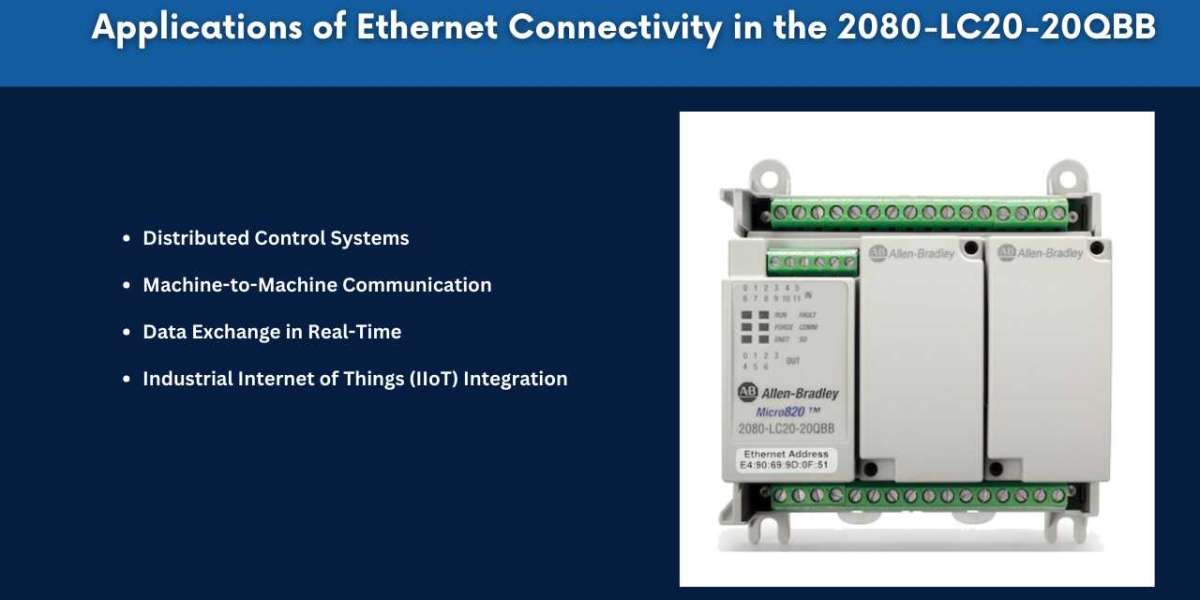Ethernet connectivity in the Allen Bradley 2080-LC20-20QBB Micro800 PLC facilitates seamless communication between various components of an industrial automation system. This includes communication with other programmable controllers, human-machine interface (HMI) devices, and other Ethernet-enabled devices on the factory floor. The controller's Ethernet capabilities enable real-time data exchange, enhancing the overall efficiency and responsiveness of the automation system.
1. Distributed Control Systems:
The PLC may take part in distributed control systems, which are systems in which several controllers work together to handle a complicated industrial process, thanks to Ethernet connectivity. This is typical in sectors like petrochemicals, where several departments must collaborate to achieve maximum efficiency.
- Centralized Control: A central control room is usually part of DCS, allowing operators to oversee and control the whole industrial process. Because of this centralization, operators can see the system holistically and make real-time, well-informed choices and modifications.
- Distributed Controllers: Different from conventional PLCs (Programmable Logic Controllers), DCS makes use of many dispersed controllers spread over the system. Decentralised control and parallel processing are made possible by the fact that each controller is in charge of certain process units or sections. This architecture lowers the possibility of a single point of failure influencing the entire process while also improving system dependability.
- Communication Networks: The distributed controllers, sensors, actuators, and other components in the DCS are linked by strong communication networks. These networks facilitate smooth data interchange and coordination between many components and are frequently built on industry-standard protocols like Profibus or Ethernet.
- Human-Machine Interface (HMI): Advanced Human-Machine Interface (HMI) technologies in DCS systems give operators clear graphical depictions of the whole process. In order to maximise efficiency and react to shifting circumstances, operators can interact with the system, monitor real-time data, and get alerts.
2. Machine-to-Machine Communication:
The PLC can synchronise and coordinate activities with other machines in production settings by communicating with them over Ethernet. This is especially important for industrial operations and assembly lines where exact time and sequencing are critical.
- Sensors and Actuators: Sensors that gather information from the physical world and actuators that take action in response to the data they receive are common components of M2M communication. In industrial contexts, for instance, actuators may modify machinery depending on data from sensors that detect temperature, pressure, or other characteristics.
- Connectivity: For M2M communication to be successful, connection must be dependable and effective. Typically, wired or wireless networks—which may include Bluetooth, Wi-Fi, cellular networks, or specialised industrial protocols like Zigbee—are used to link devices. The particular needs of the programme determine which connectivity option to use.
- Data Transmission Protocols: Standardised protocols are necessary for M2M communication in order to transfer data between devices. MQTT (Message Queuing Telemetry Transport), CoAP (Constrained Application Protocol), and HTTP (Hypertext Transfer Protocol) are examples of common protocols. Data sharing is made safe and efficient by these protocols.
- Edge Computing: Edge computing is used in some M2M applications to process data locally on devices instead of transmitting it to a cloud server that is centralised. This methodology lowers latency, preserves bandwidth, and facilitates faster device-level decision-making.
Check:- Rockwell Automation 2080-LC50-48QBB Micro820 Programmable Controller
3. Data Exchange in Real-Time:
High-speed data interchange is made possible via Ethernet, guaranteeing real-time communication of vital information. This is crucial for applications where the effectiveness and security of the automated process might be impacted by even a little data transmission delay.
- High Throughput: In order to process huge amounts of data rapidly and effectively, high throughput is essential. High throughput is required for applications like industrial control systems, online gaming, and video streaming to guarantee a flawless and uninterrupted user experience.
- Data Synchronization: Multiple devices or systems are frequently involved in real-time data sharing; hence, synchronisation is necessary to guarantee consistency. This is essential in situations like dispersed control systems and collaborative workspaces, where precise timing and event sequencing are vital.
- Communication Protocols: Selecting the right communication protocol is essential for exchanging data in real time. Protocols that are lightweight and efficient, such WebSockets or MQTT (Message Queuing Telemetry Transport), are frequently used to reduce overhead and speed up data delivery.
- Event-Driven Architecture: An event-driven architecture, in which systems react instantly to events or triggers, is commonly used for real-time data sharing. This method is often used in real-time analytics applications, where insights are obtained from constantly changing data.
4. Industrial Internet of Things (IIoT) Integration:
The Industrial Internet of Things (IIoT) is in line with the PLC's Ethernet connectivity. It makes it possible for the PLC to be a part of a wider network of interconnected devices, which helps to build data-driven, intelligent industrial ecosystems.
The Rockwell Automation 2080-LC20-20QBB PLC's Ethernet connectivity highlights how flexible it is to meet the needs of contemporary industrial automation. It improves the PLC's performance and adds to the overall intelligence, adaptability, and efficiency of the networked industrial automation systems it works with by offering a strong communication infrastructure. The Ethernet capabilities of the 2080-LC20-20QBB place it as a forward-thinking and essential part of the industrial control and automation environment, especially as companies continue to embrace digital transformation.
Asteam Techno Solutions Pvt. Ltd. is based out of Surat Gujarat, India. With over 10 years’ experience in selling industrial automation components we are your one stop shop for all major brands such as Allen Bradley, Siemens, Omron, VIPA, MOXA, Phoenix Contact etc…. Quick shipping on orders placed by any time. We have a rigorous quality control process that insures only the best quality components. All products guaranteed to be in working order, in good condition and come with our standard 12-month warranty.





